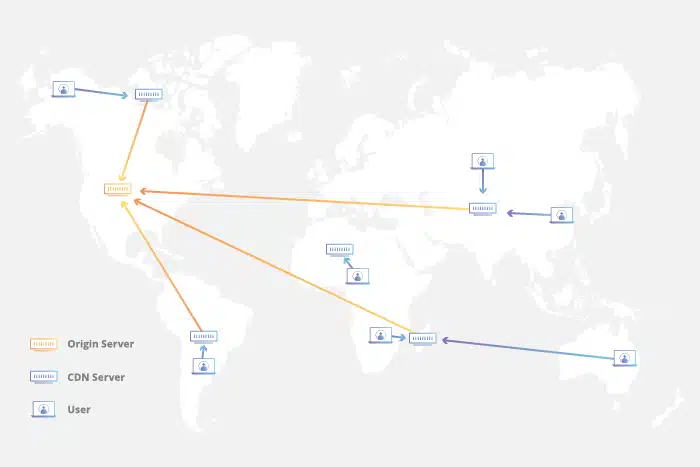CDN refers to Content Delivery Network. The Internet has shrunk and linked the world. Now people don’t have to wait weeks to hear back from family and friends who live in different countries. People on the opposite side of the world receive news in a matter of seconds thanks to the rapidity with which it travels. As a result, CDNs are critical players.
What Exactly Is a Content Delivery Network (CDN)?
With a CDN, servers and data centres are strategically placed throughout the world. Due to content delivery networks (CDNs), online pages load rapidly, giving end users quick and easy access to web-based information and services. In general, content delivery networks (CDNs) aid in enhancing the performance of websites.
Another key function of a CDN is to assist balance the load by avoiding network congestion. As a result, network traffic overload is less likely to cause service interruptions.

What Is the Workflow of Using a CDN?
When a CDN is not used, website performance degrades, resulting in long loading times for users who are far away from the server location. People in South America, for example, would have to wait for their request to go across the Atlantic in order to view material on a server in Europe. After that, the answer from the server would return to the end-user in the same length of time.
A CDN, on the other hand, located close to the end-user would improve website performance. The request travels less distance and the answer travels less distance, therefore the loading time is improved. Material is cached by CDNs, so when a user requests content that is already cached, the data is promptly returned. A CDN is made up of numerous data centres and servers.
When Choosing a CDN, Here Are 4 Things to Keep in Mind
A CDN is used by some of the largest websites to deliver the greatest possible online experience to their users. Those that choose a multi-CDN solution combine the strength of many CDNs. Static material is distributed over various CDNs in such a way that it enhances website speed while also expanding a company’s worldwide reach. With a multi-CDN approach, you can be confident that your website will always be available and secure.
Several variables need to be taken into account when selecting a CDN or multi-CDN solution, including the following.
- Performance of CDN
It’s important to note that not all CDNs are made equal. They differ from one another in terms of, among other things, performance and accessibility. When looking for a CDN solution, it’s imperative that you first conduct due diligence on the various vendors and obtain performance statistics. It’s possible to accomplish this manually by visiting the websites of each supplier and comparing their offerings, or you may deploy each solution and evaluate it. Without using CDN tools, you may utilise those that assess their performance and availability. Because you don’t have to set up every CDN solution, this saves you a lot of time and work.
- Type of Content
The first thing to think about is what kind of material you’ll be putting out there. If so, does it eat up more bandwidth because you’re consuming more media? If this is the case, you’ll want to go with a CDN service that has a guaranteed number of servers. If your material isn’t guaranteed to be served by one or more of the CDN’s many servers, it’s a waste of time and money.
Check to see if the CDN has the capability to locally cache videos. When it comes to B2B websites, a CDN that specialises in serving businesses is the way to go.
- User Location
It is the objective of any website owner to give their customers a great experience no matter where they are in the world. In order to choose a CDN with servers near your normal visitors, you must know where your website’s visitors come from.
If the majority of your users are located in India, a CDN with Indian servers would be the best option. If, on the other hand, your target audience is global, you may want to go with a supplier that has servers on every continent. Another alternative is to use a multi-CDN system, which allows you to use several CDN providers.
- Customization of the Information
Content personalisation is proving to be a lucrative strategy for many companies, who are putting it to use everywhere they can. For example, the quality of a video would have to be automatically modified based on a user’s device, subscriber profile, and Internet connection, among other factors. Mobile optimization is required for all forms of content.
Personalization and customisation can have a negative impact on website speed and performance, especially if a CDN provider lacks the network to support such features.. Because of this, be certain that the CDN you choose enables content customisation before making your final decision.
Conclusion
CDNs have improved the way material is delivered. The user’s experience has improved since the speed and responsiveness of the website have both been enhanced. While picking a CDN provider might be difficult, following a few suggestions will make the process go more smoothly. There are also multi-CDN options available, allowing you to select from a number of different service providers.

